|
A Walk Through the Major Families of Moths
|
There are approximately 65 families of moths found in North America, or perhaps 70 if all recent suggestions for taxonomic changes are followed. Representatives of about 25 of them, mostly of the larger families, are shown here. They are a diverse and colorful group of animals.
|
|
Gracillariidae
|
These are very tiny micromoths, usually 5-7 mm in length and less than 1 mm in apparent body diameter when at rest. Think of something as small or smaller than a midge or mosquito. In most cases the larvae are leafminers that tunnel or "mine" between the outer layers of a leaf.
|
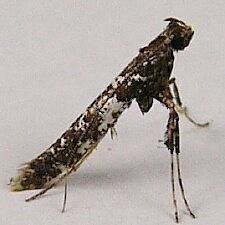 Unidentified Caloptilia sp.
Unidentified Caloptilia sp.
© Robert Patterson
- MD
|
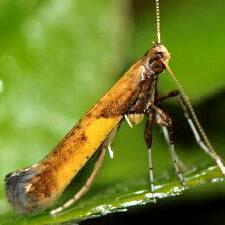 Azalea Leaf-miner Moth
Azalea Leaf-miner Moth
© Richard Leung
- VA
|
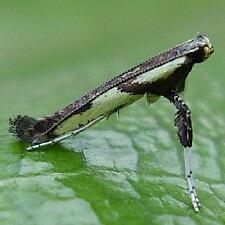 Blandella Leaf-miner Moth
Blandella Leaf-miner Moth
© Machele White - FL
|
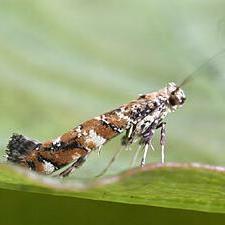 Caloptilia syringella
Caloptilia syringella
© Ian Kimber
- UK
|
|
|
Oecophoridae
|
This is a diverse family of medium-sized moths (typically 6-15 mm in length). Larvae usually feed while concealed in webs of one kind or another (rolled leaves, for instance). Some feed on dead leaves, dead animal matter, or fungi. Promalactis suzukiella is a recently introduced species.
|
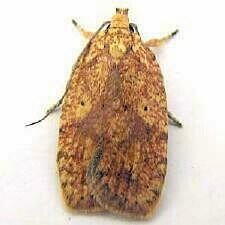 Agonopterix robiniella
Agonopterix robiniella
© Robert Patterson
- MD
|
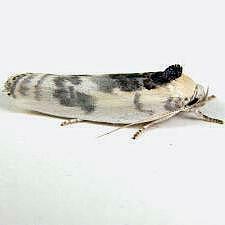 Schlaeger's Fruitworm Moth
Schlaeger's Fruitworm Moth
© Robert Patterson
- MD - 15.5mm
|
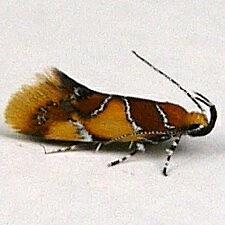 Epicallima argenticinctella
Epicallima argenticinctella
© Robert Patterson
- MD
|
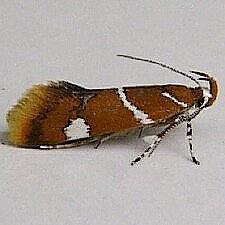 Promalactis suzukiella [T]
Promalactis suzukiella [T]
© Robert Patterson
- MD
|
|
|
Coleophoridae
-- Casebearer Moths
|
In this family of small micromoths we find the interesting habit, on the part of the larvae, of constructing protective cases in which they move about while feeding. These cases take on distinctive designs that may be reflected in common names given to the species.
|
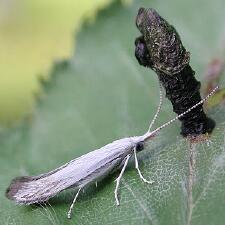 American Pistol Casebearer Moth
American Pistol Casebearer Moth
© John Himmelman - CT
|
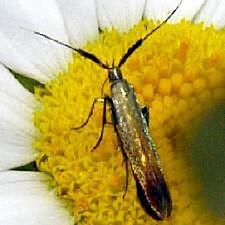 Metallic Coleophora Moth
Metallic Coleophora Moth
© Robert Patterson - MD
|
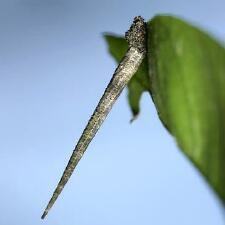 Octagonal Casemaker Moth
Octagonal Casemaker Moth
© Troy Bartlett - GA
|
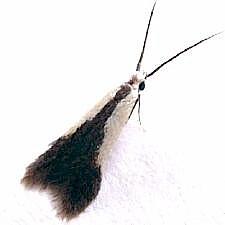 Unidentified Coleophora sp.
Unidentified Coleophora sp.
© Robert Patterson - MD
|
|
|
Momphidae
|
Agonoxenidae
|
Cosmopterigidae
|
Gelechiidae
|
|
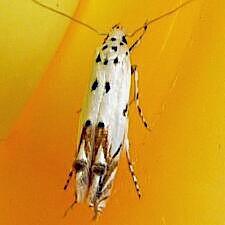 Mompha eloisella
Mompha eloisella
© Robert Patterson
- MD
|
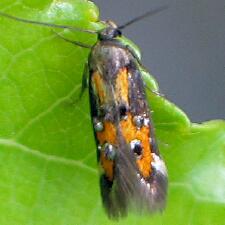 Lime-tree Moth
Lime-tree Moth
© Lynette Schimming - NC
|
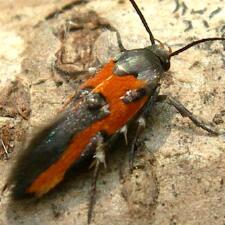 Euclemensia bassettella
Euclemensia bassettella
© Randy Newman - NC
|
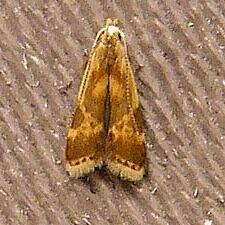 Least Dichomeris Moth
Least Dichomeris Moth
© Robert Patterson
- MD - 3.5 mm
|
|
|
Alucitidae
|
Glyphipterigidae
|
Plutellidae
|
Yponomeutidae
|
|
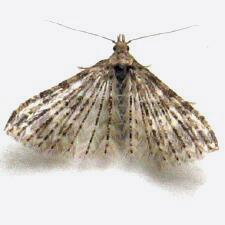 Six-plume Moth
Six-plume Moth
© Larry Line
- CO
|
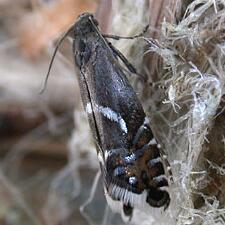 Hayworth's Glyphipterid Moth
Hayworth's Glyphipterid Moth
© Ian Kimber - UK
|
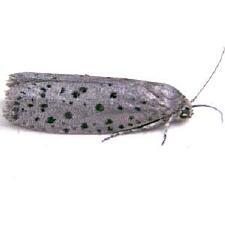 Mimosa Webworm Moth
Mimosa Webworm Moth
© Robert Patterson
- MD
|
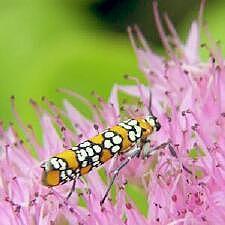 Ailanthus Webworm Moth
Ailanthus Webworm Moth
© Robert Patterson
- MD
|
|
|
Sesiidae -- Clear-winged Borer Moths
|
This is an interesting family for a variety of reasons, not least of which is that its members are day-flying moths. Adults nectar at flowers and may be helpful in polination. Larvae bore into various parts of plant, often cultivated trees and crop plants, and may be an economic nuisance.
|
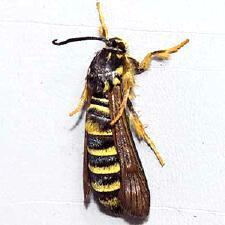 Raspberry Crown Borer Moth
Raspberry Crown Borer Moth
© Anthony W. Thomas - NB
|
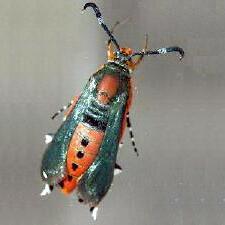 Squash Vine Borer Moth
Squash Vine Borer Moth
© Richard Breen
- WI
|
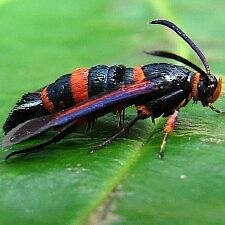 Florida Oak Gall Moth
Florida Oak Gall Moth
© Machele White - FL
|
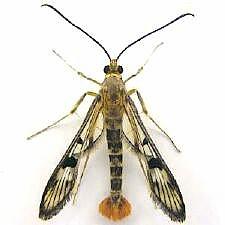 Maple Callus Borer Moth
Maple Callus Borer Moth
© Robert Patterson - MD
|
|
|
Tortricidae
|
This is a large family of small moths (typically 6-12 mm in length) with representatives in almost all habitats. Many of those that have been given common names are known as Leaftiers, Leafrollers and so forth. Some are serious pests such as the apple Codling Moth.
|
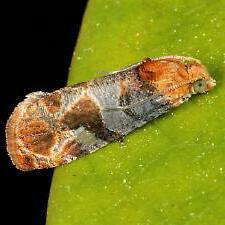 Tulip-tree Leaftier Moth
Tulip-tree Leaftier Moth
© Paul McNelis - PA
|
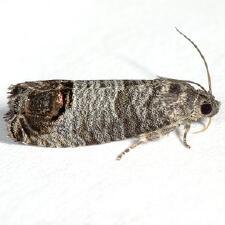 Codling Moth
Codling Moth
© Nolie Schneider - ON
|
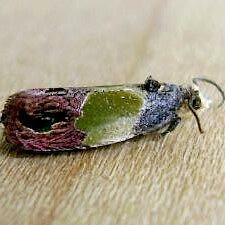 Sculptured Moth
Sculptured Moth
© Machele White - FL
|
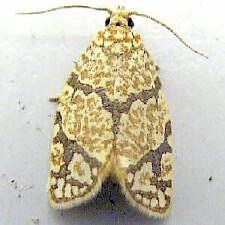 Oak Leafroller Moth
Oak Leafroller Moth
© Robert Patterson - MD
|
|
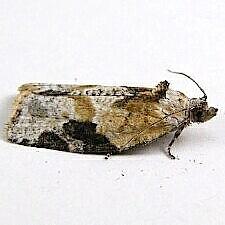 Gray-banded Leafroller Moth
Gray-banded Leafroller Moth
© Robert Patterson - MD
|
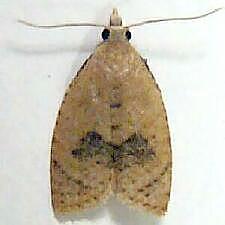 The Batman Moth
The Batman Moth
© Robert Patterson - MD
|
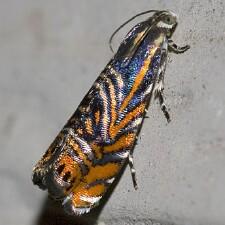 Thaumatographa jonesi
Thaumatographa jonesi
© Arlene Ripley - MD
|
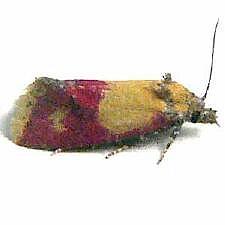 Primrose Cochylis Moth
Primrose Cochylis Moth
© Robert Patterson - MD
|
|
|
Zygaenidae
|
Megalopygidae
|
Limacodidae
|
Epipyropidae
|
|
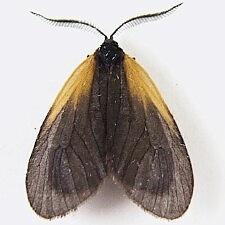 Orange-patched Smoky Moth
Orange-patched Smoky Moth
© Robert Patterson
- MD
|
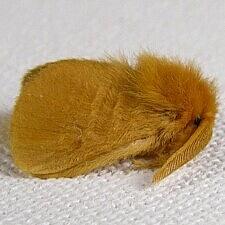 Yellow Flannel Moth
Yellow Flannel Moth
© Robert Patterson
- FL
|
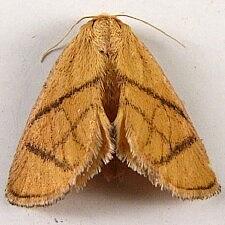 Yellow-collared Slug Moth
Yellow-collared Slug Moth
© Robert Patterson
- MD
|
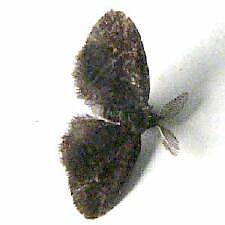 Planthopper Parasite Moth
Planthopper Parasite Moth
© Robert Patterson
- MD
|
|
|
Pyralidae - Crambidae
|
Like the Tortricidae this is a group that exceeds 1,000 species found in diverse habitats throughout the continent. Some of its species are considered pests of agriculture and horticulture. Others have been introduced to North America as biological control agents of weedy plants.
|
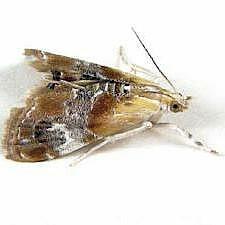 Julia's Dicymolomia Moth
Julia's Dicymolomia Moth
© Robert Patterson
- MD
|
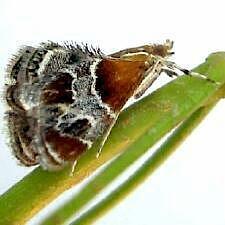 Pegasus Chalcoela Moth
Pegasus Chalcoela Moth
© Machele White - FL
|
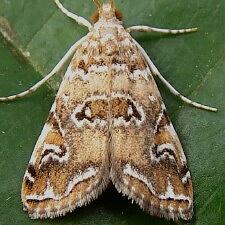 Waterlily Borer Moth
Waterlily Borer Moth
© Machele White - FL
|
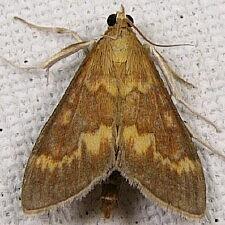 European Corn Borer Moth
European Corn Borer Moth
© Robert Patterson
- MD
|
|
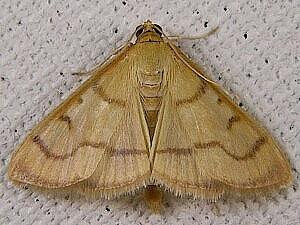 Neohelvibotys neohelvialis
Neohelvibotys neohelvialis
© Robert Patterson
- MD
|
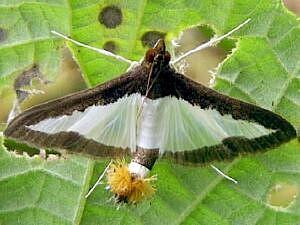 Melonworm Moth
Melonworm Moth
© Robert Patterson
- FL
|
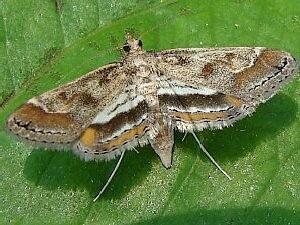 Obscure Pondweed Moth
Obscure Pondweed Moth
© Machele White - FL
|
|
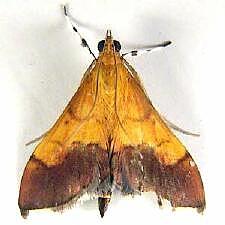 Bicolored Pyrausta Moth
Bicolored Pyrausta Moth
© Robert Patterson
- MD
|
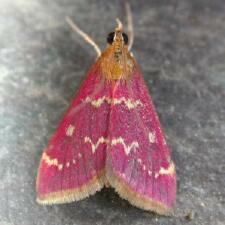 Raspberry Pyrausta Moth
Raspberry Pyrausta Moth
© David Bree - ON
|
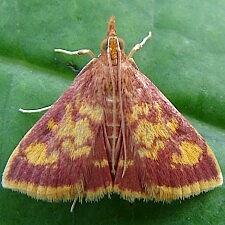 Mint-loving Pyrausta Moth
Mint-loving Pyrausta Moth
© Machele White - MD
|
 White-spotted Sable Moth
White-spotted Sable Moth
© Anthony W. Thomas - NB
|
|
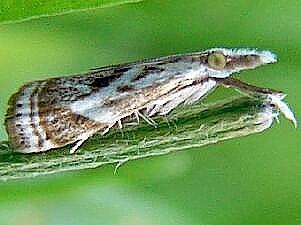 Elegant Grass-veneer Moth
Elegant Grass-veneer Moth
© Robert Patterson
- PA
|
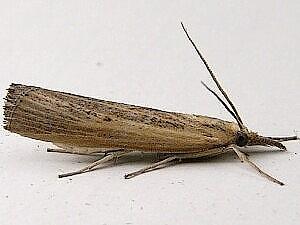 Sod Webworm Moth
Sod Webworm Moth
© Robert Patterson
- MD
|
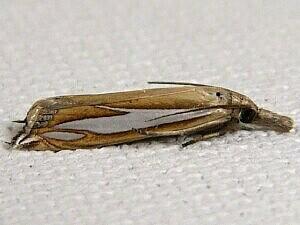 Crambus satrapellus
Crambus satrapellus
© Robert Patterson
- FL
|
|
|
Pterophoridae -- The Plume Moths
|
Plume Moths are fun to observe. It takes some convincing of yourself to believe they are actually moths. The wings are deeply lobed and well illustrated in Jim Vargo's spread specimen. In real life it is difficult to see the hindwing. Sometimes you see just one lobe looking like a haltere.
|
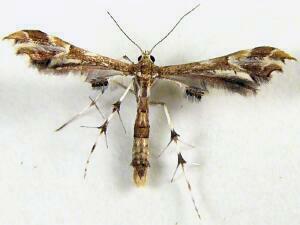 Geina periscelidactyla
Geina periscelidactyla
© Robert Patterson
- MD
|
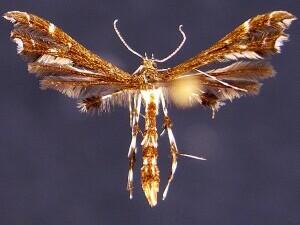 Geina buskii
Geina buskii
© Jim Vargo - IN
|
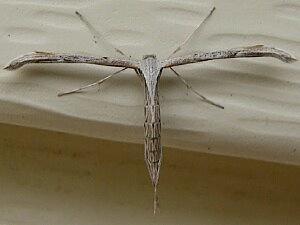 Morning-glory Plume Moth
Morning-glory Plume Moth
© Robert Patterson
- MD
|
|
|
Geometridae
-- The Inchworm or Geometer Moths
|
One of the largest moth families, the Geometridae are found wherever moths are found in North America. For the most part they spread their wings fully when at rest. Colors run the gamut from drab to spectacular. There are many instances in this family of flightless females.
|
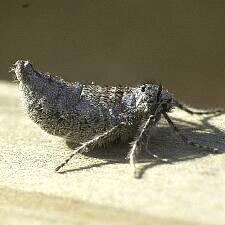 Fall Cankerworm Moth
Fall Cankerworm Moth
[f.] - © Charles Lewallen - OK
|
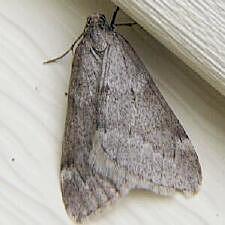 Fall Cankerworm Moth
Fall Cankerworm Moth
[m.] - © Robert Patterson - MD
|
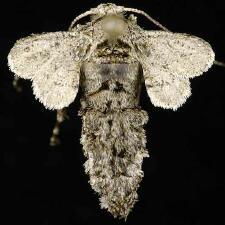 The Half-wing Moth
The Half-wing Moth
[f.] - © Anthony W. Thomas - NB
|
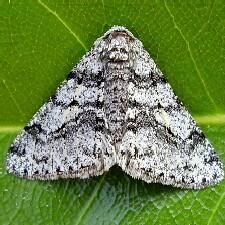 The Half-wing Moth
The Half-wing Moth
[m.] - © Machele White - FL
|
|
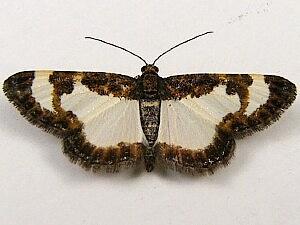 Common Spring Moth
Common Spring Moth
© Robert Patterson
- MD
|
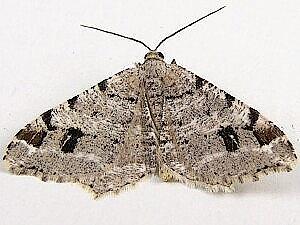 Hemlock Angle Moth
Hemlock Angle Moth
© Robert Patterson
- MD
|
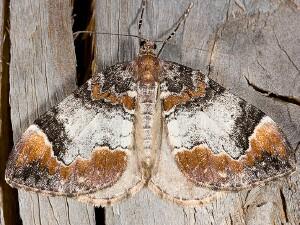 Orange-marked Hazelnut Moth
Orange-marked Hazelnut Moth
© John Davis - WA
|
|
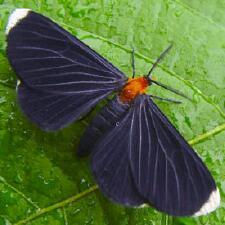 White-tipped Black Moth
White-tipped Black Moth
© Alan Chin-Lee - FL
|
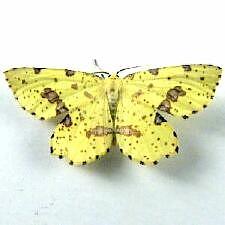 Crocus Geometer sp. grp.
Crocus Geometer sp. grp.
© Robert Patterson
- MD
|
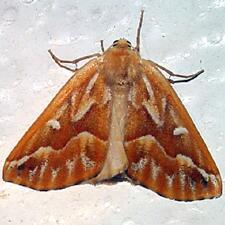 Northern Pine Looper Moth
Northern Pine Looper Moth
© Tom Murray - MA
|
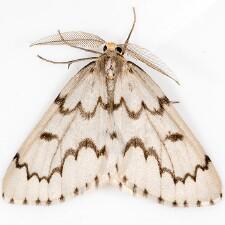 Phantom Hemlock Looper Moth
Phantom Hemlock Looper Moth
© John Davis - WA
|
|
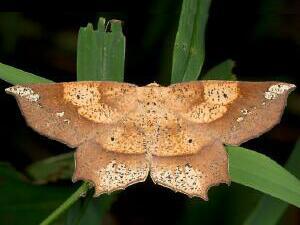 Deep Yellow Euchlaena Moth
Deep Yellow Euchlaena Moth
© Troy Bartlett - GA
|
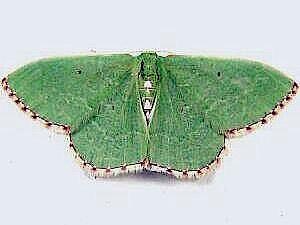 Red-bordered Emerald Moth
Red-bordered Emerald Moth
© Robert Patterson
- MD
|
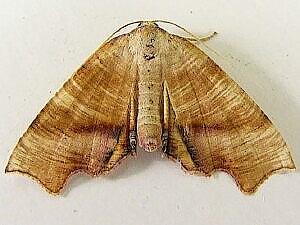 Fervid Plagodis Moth
Fervid Plagodis Moth
© Robert Patterson
- MD
|
|
|
Saturniidae -- Giant Silkmoths
|
In this family we find our largest resident moths of North America and some of our most colorful ones.
|
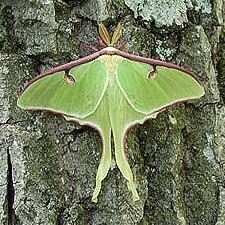 Luna Moth
Luna Moth
© John Himmelman - CT
|
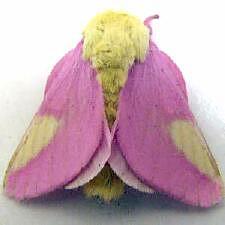 Rosy Maple Moth
Rosy Maple Moth
© Robert Patterson - MD
|
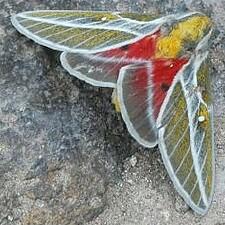 Sphingicampa raspa
Sphingicampa raspa
© Alexis White - Mexico
|
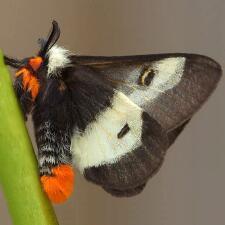 Buck Moth
Buck Moth
© Ronnie Gaubert - LA
|
|
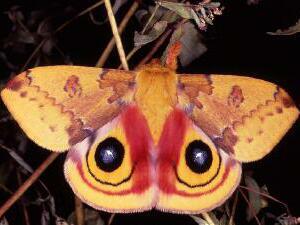 Io Moth
Io Moth
© Ronnie Gaubert - LA
|
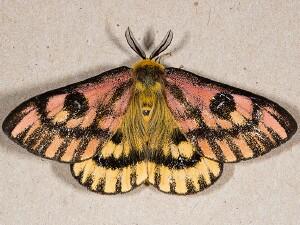 Elegant Sheepmoth
Elegant Sheepmoth
© John Davis - WA
|
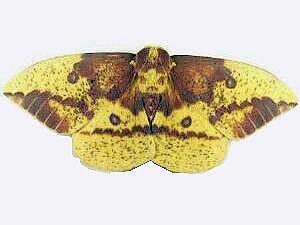 Imperial Moth
Imperial Moth
© Robert Patterson - MD
|
|
|
Sphingidae -- Sphinx Moths or Hawkmoths
|
These are rapid flyers that nectar at flowers. Some are crepuscular and some diurnal. Most are readily attracted to lights. They are often seen in the floodlights high above athletic fields, and sometimes land on my driveway where I must be careful not to step on them as they snooze away.
|
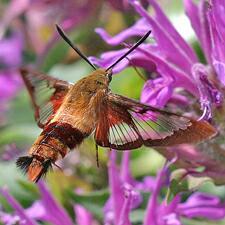 Hummingbird Clearwing Moth
Hummingbird Clearwing Moth
© Nolie Schneider - ON
|
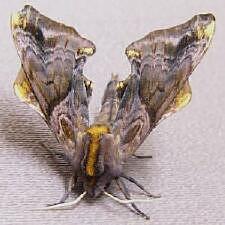 Small-eyed Sphinx Moth
Small-eyed Sphinx Moth
© Robert Patterson - MD
|
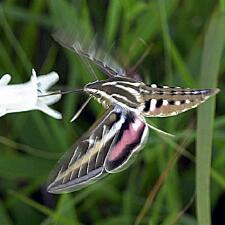 White-lined Sphinx Moth
White-lined Sphinx Moth
© Charles Lewallen - OK
|
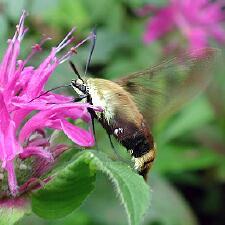 Snowberry Clearwing Moth
Snowberry Clearwing Moth
© John Himmelman - CT
|
|
|
Arctiidae -- Our Most Colorful Family
|
I may get some argument about "most colorful family," but that's how impressed I am by these moths. Many of them are day flyers found nectaring at wild and garden flowers. Many of them are also attracted to lights. Diversity in size, color and pattern is rampant in this family.
|
 Hickory Tussock Moth
Hickory Tussock Moth
© Robert Patterson
- MD
|
 Scarlet-winged Lichen Moth
Scarlet-winged Lichen Moth
© Robert Patterson
- MD
|
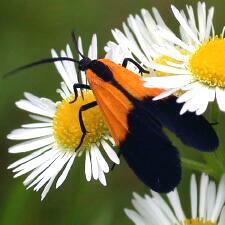 Black-and-Yellow Lichen Moth
Black-and-Yellow Lichen Moth
© Cheryl Johnson - NH
|
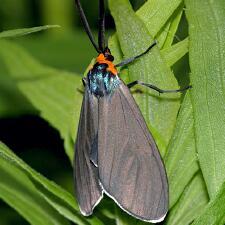 Virginia Ctenucha Moth
Virginia Ctenucha Moth
© Tom Murray - MA
|
|
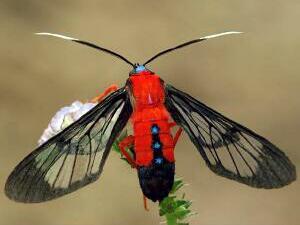 Scarlet-bodied Wasp Moth
Scarlet-bodied Wasp Moth
© Ronnie Gaubert - LA
|
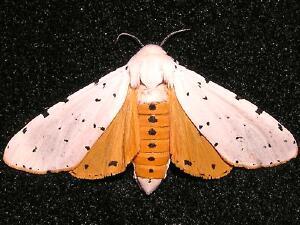 Salt Marsh Moth [m.]
Salt Marsh Moth [m.]
© Scott Nelson - FL
|
 Polka-dot Wasp Moth
Polka-dot Wasp Moth
© Machele White - FL
|
|
|
Noctuidae
-- The Largest Family
|
With more than 3,000 species in North America it is difficult to select a few examples to be representative of the whole. Modern taxonomists have recently placed some species in a new family, the Nolidae, and there are further such proposals under consideration.
|
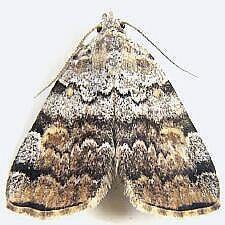 American Idia Moth
American Idia Moth
© Robert Patterson
- MD
|
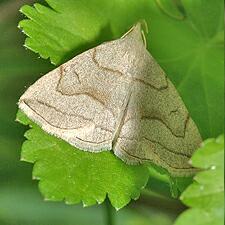 Grayish Zanclognatha Moth
Grayish Zanclognatha Moth
© Nolie Schneider - ON
|
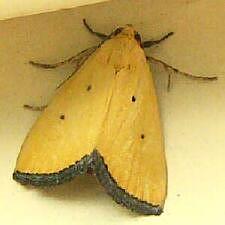 Black-bordered Lemon Moth
Black-bordered Lemon Moth
© Robert Patterson
- MD
|
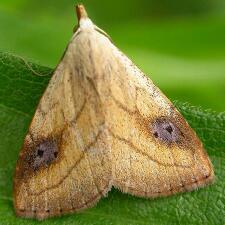 Spotted Grass Moth
Spotted Grass Moth
© Bev Wigney - ON
|
|
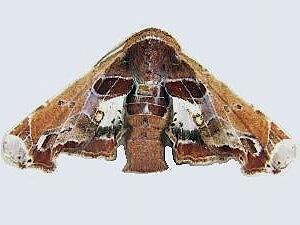 Beautiful Eutelia Moth
Beautiful Eutelia Moth
© Robert Patterson
- MD
|
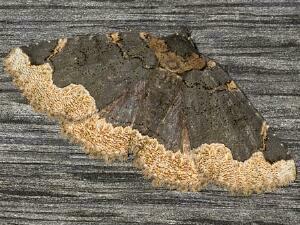 Horrid Zale Moth
Horrid Zale Moth
© Stephen Cresswell - WV
|
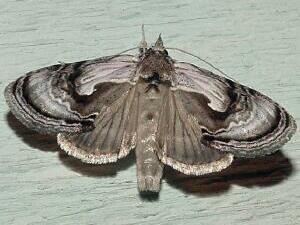 Formosa Looper Moth
Formosa Looper Moth
© Tom Murray - MA
|
|
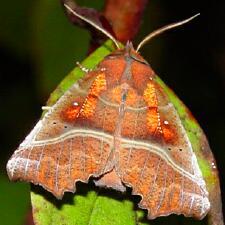 The Herald Moth
The Herald Moth
© Tim Dyson - ON
|
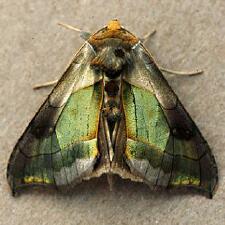 Hologram Moth
Hologram Moth
© Janice Stiefel - WI
|
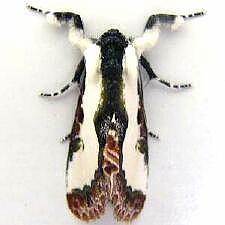 Pearly Wood-nymph Moth
Pearly Wood-nymph Moth
© Robert Patterson
- MD
|
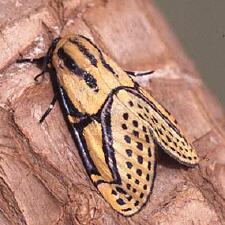 Heiroglyphic Moth
Heiroglyphic Moth
© James Adams - GA
|
|
 Eyed Paectes Moth
Eyed Paectes Moth
© Stephen Cresswell - WV
|
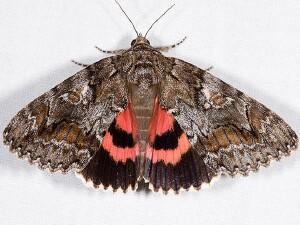 Aholibah Underwing Moth
Aholibah Underwing Moth
© John Davis - WA
|
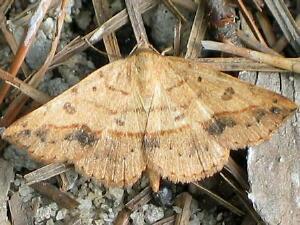 Variable Tropic Moth
Variable Tropic Moth
© Lynette Schimming - NC
|
|
 Unidentified Caloptilia sp.
Unidentified Caloptilia sp.
 Azalea Leaf-miner Moth
Azalea Leaf-miner Moth
 Blandella Leaf-miner Moth
Blandella Leaf-miner Moth
 Caloptilia syringella
Caloptilia syringella
 Agonopterix robiniella
Agonopterix robiniella
 Schlaeger's Fruitworm Moth
Schlaeger's Fruitworm Moth
 Epicallima argenticinctella
Epicallima argenticinctella
 Promalactis suzukiella [T]
Promalactis suzukiella [T]
 American Pistol Casebearer Moth
American Pistol Casebearer Moth
 Metallic Coleophora Moth
Metallic Coleophora Moth
 Octagonal Casemaker Moth
Octagonal Casemaker Moth
 Unidentified Coleophora sp.
Unidentified Coleophora sp.
 Mompha eloisella
Mompha eloisella
 Lime-tree Moth
Lime-tree Moth
 Euclemensia bassettella
Euclemensia bassettella
 Least Dichomeris Moth
Least Dichomeris Moth
 Six-plume Moth
Six-plume Moth
 Hayworth's Glyphipterid Moth
Hayworth's Glyphipterid Moth
 Mimosa Webworm Moth
Mimosa Webworm Moth
 Ailanthus Webworm Moth
Ailanthus Webworm Moth
 Raspberry Crown Borer Moth
Raspberry Crown Borer Moth
 Squash Vine Borer Moth
Squash Vine Borer Moth
 Florida Oak Gall Moth
Florida Oak Gall Moth
 Maple Callus Borer Moth
Maple Callus Borer Moth
 Tulip-tree Leaftier Moth
Tulip-tree Leaftier Moth
 Codling Moth
Codling Moth
 Sculptured Moth
Sculptured Moth
 Oak Leafroller Moth
Oak Leafroller Moth
 Gray-banded Leafroller Moth
Gray-banded Leafroller Moth
 The Batman Moth
The Batman Moth
 Thaumatographa jonesi
Thaumatographa jonesi
 Primrose Cochylis Moth
Primrose Cochylis Moth
 Orange-patched Smoky Moth
Orange-patched Smoky Moth
 Yellow Flannel Moth
Yellow Flannel Moth
 Yellow-collared Slug Moth
Yellow-collared Slug Moth
 Planthopper Parasite Moth
Planthopper Parasite Moth
 Julia's Dicymolomia Moth
Julia's Dicymolomia Moth
 Pegasus Chalcoela Moth
Pegasus Chalcoela Moth
 Waterlily Borer Moth
Waterlily Borer Moth
 European Corn Borer Moth
European Corn Borer Moth
 Neohelvibotys neohelvialis
Neohelvibotys neohelvialis
 Melonworm Moth
Melonworm Moth
 Obscure Pondweed Moth
Obscure Pondweed Moth
 Bicolored Pyrausta Moth
Bicolored Pyrausta Moth
 Raspberry Pyrausta Moth
Raspberry Pyrausta Moth
 Mint-loving Pyrausta Moth
Mint-loving Pyrausta Moth
 White-spotted Sable Moth
White-spotted Sable Moth
 Elegant Grass-veneer Moth
Elegant Grass-veneer Moth
 Sod Webworm Moth
Sod Webworm Moth
 Crambus satrapellus
Crambus satrapellus
 Geina periscelidactyla
Geina periscelidactyla
 Geina buskii
Geina buskii
 Morning-glory Plume Moth
Morning-glory Plume Moth
 Fall Cankerworm Moth
Fall Cankerworm Moth
 Fall Cankerworm Moth
Fall Cankerworm Moth
 The Half-wing Moth
The Half-wing Moth
 The Half-wing Moth
The Half-wing Moth
 Common Spring Moth
Common Spring Moth
 Hemlock Angle Moth
Hemlock Angle Moth
 Orange-marked Hazelnut Moth
Orange-marked Hazelnut Moth
 White-tipped Black Moth
White-tipped Black Moth
 Crocus Geometer sp. grp.
Crocus Geometer sp. grp.
 Northern Pine Looper Moth
Northern Pine Looper Moth
 Phantom Hemlock Looper Moth
Phantom Hemlock Looper Moth
 Deep Yellow Euchlaena Moth
Deep Yellow Euchlaena Moth
 Red-bordered Emerald Moth
Red-bordered Emerald Moth
 Fervid Plagodis Moth
Fervid Plagodis Moth
 Luna Moth
Luna Moth
 Rosy Maple Moth
Rosy Maple Moth
 Sphingicampa raspa
Sphingicampa raspa
 Buck Moth
Buck Moth
 Io Moth
Io Moth
 Elegant Sheepmoth
Elegant Sheepmoth
 Imperial Moth
Imperial Moth
 Hummingbird Clearwing Moth
Hummingbird Clearwing Moth
 Small-eyed Sphinx Moth
Small-eyed Sphinx Moth
 White-lined Sphinx Moth
White-lined Sphinx Moth
 Snowberry Clearwing Moth
Snowberry Clearwing Moth
 Hickory Tussock Moth
Hickory Tussock Moth
 Scarlet-winged Lichen Moth
Scarlet-winged Lichen Moth
 Black-and-Yellow Lichen Moth
Black-and-Yellow Lichen Moth
 Virginia Ctenucha Moth
Virginia Ctenucha Moth
 Scarlet-bodied Wasp Moth
Scarlet-bodied Wasp Moth
 Salt Marsh Moth [m.]
Salt Marsh Moth [m.]
 Polka-dot Wasp Moth
Polka-dot Wasp Moth
 American Idia Moth
American Idia Moth
 Grayish Zanclognatha Moth
Grayish Zanclognatha Moth
 Black-bordered Lemon Moth
Black-bordered Lemon Moth
 Spotted Grass Moth
Spotted Grass Moth
 Beautiful Eutelia Moth
Beautiful Eutelia Moth
 Horrid Zale Moth
Horrid Zale Moth
 Formosa Looper Moth
Formosa Looper Moth
 The Herald Moth
The Herald Moth
 Hologram Moth
Hologram Moth
 Pearly Wood-nymph Moth
Pearly Wood-nymph Moth
 Heiroglyphic Moth
Heiroglyphic Moth
 Eyed Paectes Moth
Eyed Paectes Moth
 Aholibah Underwing Moth
Aholibah Underwing Moth
 Variable Tropic Moth
Variable Tropic Moth